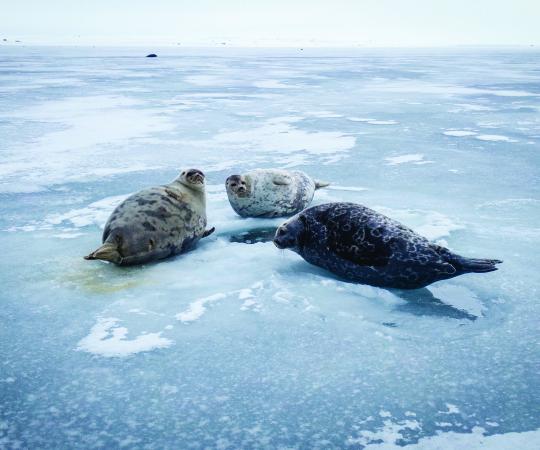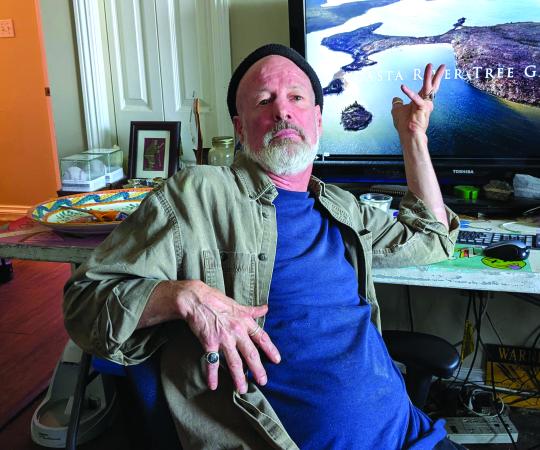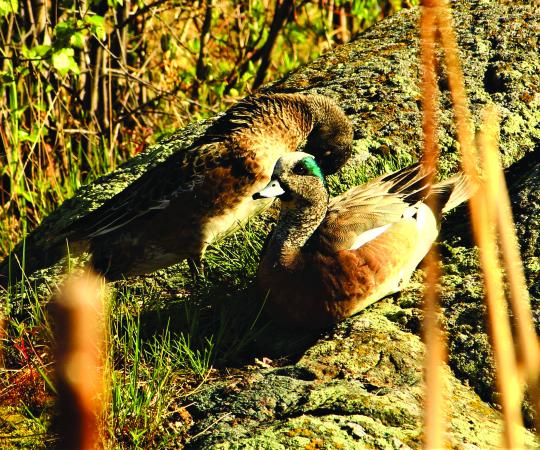Late April, Yellowknife….and snow still covers most surfaces on the shores of Yellowknife’s Kam Lake. At Qimmiq Kennels, with 80 plus rambunctious day camp dogs cavorting below them, four pairs of magpies go about their daily activities with casual aplomb. They flit about in great looping curves, carrying sticks to remodel their nests, pitching up to perch confidently on fences, kennel buildings, trees and power poles, flashing their white wing patches and flicking their long tails. The members of each pair perch near each other, and call back and forth. As of May 1, laying and incubation do not seem to have started as the birds are still carrying sticks. I have also seen them picking up bits of the soaked and deteriorating pellets for the pellet stove; they may be incorporating these into the nest, as there is little mud available yet. One of these magpies caches food in the top of a fence post.
These are Black-billed Magpies (Pica hudsonia), long resident on the western prairies and northwest through the southwestern corner of Yukon to Alaska. They were not common north of sixty until the 1990s, and still are not marked on many range maps as occupying Canada’s Northwest Territories. But they are clearly expanding their range, and have become much more common during the past three decades. Due to the number of sled dogs in Kam Lake, magpies are particularly common there. Along with ravens, they feed on spilled dog food, and find abundant nesting habitat in the trees along the fences and at the edge of the lake.
Magpies are members of the family Corvidae, which includes the jays, crows, and ravens. Members of this family are intelligent, inventive, adaptive, and have a well-developed sense of curiosity and what appears to be humour.
Black-billed Magpies are handsome birds, strikingly black and white. A white “cape” across their backs and white primary feathers with black tips ensure that these crow-sized birds are flashy in flight. However, it is their iridescent feathers that make them so memorable; their feathers shine black to blue to blue-green on their backs and long tails, including the side feathers of the tails. This iridescence is due to reflecting platelets in the feathers, that results when the light from one layer interferes with the reflections from another. If you hold a magpie feather to allow sunlight to pass through it, it will appear dark brown to blackish, due to melanin pigments. But turn the feather so the sun reflects off the surface and it becomes an iridescent blue green to purplish. Not pigments, but reflection and refraction.

Magpies are among only a few North American birds that build “domed nests”–their large, messy stick nests in low trees or large shrubs contain a central nest bowl of mud, similar to a robin’s nest, and lined by the female with fine grasses, hair, and fur. There may be more than one entrance to a nest. Magpie nest building often starts in January or February, and can represent two months’ work on the part of a pair of birds.
Magpies are monogamous, mating for years, if not for life, and both members of the pair build the nest. However, they may not agree on the particular site, so two or more nests may be started. Usually the male, some 12-15 percent larger than the female, carries the larger sticks to the nest. Extra nests may provide repair material for the main nest, once the female settles on the one she prefers.
Ravens in our area actively and aggressively pursue magpies and prey on their eggs and young, pulling them out of the nest and killing them on the ground. According to Qimmiq Kennels owner Jo Kelly, one local pair of magpies seem to have found a solution. Last year they nested inside a shed, accessing it by a hole too small for ravens and building their bulky nest inside, out of the reach of the ravens.
Conversely, magpies prey on smaller birds like warblers and sparrows, feeding on eggs, nestlings, and fledglings. Research on magpie predation in European magpies (Pica pica), revealed that, although predation was observed, it did not negatively affect local populations of small birds. Domestic cats kill more small birds than any avian predator.
Depending on their diet, magpies, like raptors, produce pellets of undigested material, which they regurgitate while perching. Studies in the Edmonton area on winter-roosting magpies revealed that these pellets contain much vegetative matter, including grain hulls and chaff, seeds of berries or cherries, bark, and also bones of meadow voles and a significant amount of human trash. Insects such as grasshoppers, beetles and flies make up much of their summer diet. Magpies feed on road kill of any size, and on the remains of other predators’ kills, often following coyotes and wolves to scavenge bits of their kills.
Historically, the black-billed magpie followed bison, elk, and moose, feeding on ticks and flies around the large ungulates. Today, they utilize cattle and to a lesser amount, sheep and farmed bison, feeding actively on ticks and other insects. However, some magpies have learned that they can derive some nutrition from wounds on animals, feeding either on maggots in the wounds or on the edges of the wounds themselves. This does not endear them to ranchers, who have for years tried to control magpies by shooting them. Most magpies have become hypersensitive to attempts to stalk them, especially using guns or long lenses, and it is hard to sneak up on a magpie.
Legend has it that magpies are attracted to shiny objects, and indeed there are many stories of captive birds playing with and carrying bits of foil and metal objects, but scientific studies in wild magpies indicate that wild birds are extra cautious around shiny objects and usually actively avoid them. They have an undeserved reputation for stealing jewellery, but this seems entirely based on an 1815 opera by Rossini called The Thieving Magpie in which a maid is accused of stealing the household silver, and is nearly executed. At the last minute the thief is discovered to be a magpie which is hiding the silver in the tower of the church. It is likely totally fictional.
Like many other Corvids, magpies tend to roost in flocks in winter, but only share the trees; they do not huddle together, as do some smaller birds. In the Yellowknife area, many magpies remain all year and do not migrate.
These handsome birds get a lot of negative press, mostly undeserved. They are protected under the Migratory Bird Treaty Act in the US, but control is allowed when the birds are destroying property, fruit trees, or causing problems with livestock. However, in Canada, they are not listed as protected under the Migratory Birds Convention Act. Provincial laws apply, but, for example, in Alberta they are not protected, and can be shot without a license. On the whole, their populations are shrinking, which may in part be due to less agriculture and to the toxic effects of pour-on insecticides used on cattle.









